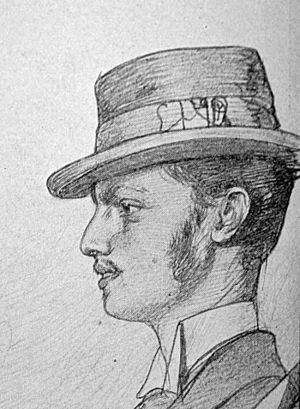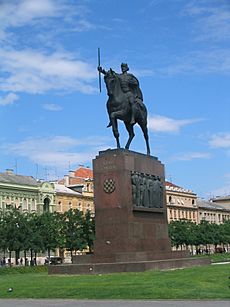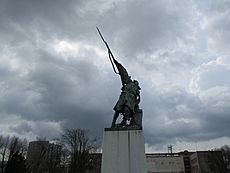Robert Frangeš-Mihanović facts for kids
Quick facts for kids
Robert Frangeš-Mihanović
|
|
|---|---|

Frangeš-Mihanović in an 1893 drawing by Christian Wilhelm Allers
|
|
| Born | 2 October 1872 Sremska Mitrovica, Kingdom of Croatia-Slavonia, Austria-Hungary
|
| Died | 12 January 1940 (aged 67) Zagreb, Banovina of Croatia, Kingdom of Yugoslavia
|
| Known for | Sculpture |
Robert Frangeš-Mihanović (born October 2, 1872 – died January 12, 1940) was an important Croatian artist. He was a sculptor, meaning he created art by shaping materials like stone or metal. Many people see him as a pioneer, or a very early leader, of modern Croatian sculpture. He also helped start and organize many art events and groups in Zagreb around the year 1900.
Life of Robert Frangeš-Mihanović
Robert Frangeš-Mihanović was born on October 2, 1872. His birthplace was Sremska Mitrovica, which was then part of Austria-Hungary. Today, this city is located in Serbia.
He finished his studies at the School of Crafts in Zagreb in 1889. After that, he moved to Vienna to continue his education. In Vienna, he studied at the Arts and Crafts School from 1889 to 1894. He then attended the Art Academy in 1894 and 1895. Later, he traveled to Paris for more studies between 1900 and 1901. While in Paris, he met two famous sculptors, Auguste Rodin and Medardo Rosso.
Frangeš-Mihanović taught at the School of Crafts in Zagreb from 1895 to 1907. He also taught sculpture at the Art Academy. He was very active in the art world of Zagreb. He helped create the Croatian Artists' Society in 1897. He also co-founded Lado, a folklore society, in 1904. In 1907, he helped establish the Art Academy itself.
He started the first bronze foundry at the Academy. A foundry is a place where metal is melted and shaped. He even brought the first workers who knew how to cast bronze. He was a member of several important academies, including the JAZU, SANU, and the Prague academy. Robert Frangeš-Mihanović passed away in Zagreb on January 12, 1940. He is remembered as a key figure in modern Croatian sculpture, along with Rudolf Valdec.
Famous Sculptures and Artworks

Frangeš-Mihanović created many important artworks. His small sculptures, like medals and plaques, are very well-known. These often showed figures of people or animals. Some examples include Heracles the Bull (1899), Vineyard Workers (1900), Turkey (1904), and Laborer (1906). These works are seen as the beginning of Croatian medal making.
In 1897, he made The Dying Soldier. This was a monument to soldiers who died in Osijek. This sculpture, along with his Philosophy (1897) in Zagreb, are early examples of impressionism in Croatian sculpture. Impressionism is an art style that focuses on capturing a moment or feeling.
His largest and most famous work is the equestrian sculpture of King Tomislav. An equestrian sculpture shows a person riding a horse. He worked on this piece from 1928 to 1938. It was finally put in place in Zagreb in 1947.
He also created statues for graves. These include Monument to Death (1906) in Varaždin and Worker (1935) in Mirogoj. He also designed parts of buildings in Zagreb. For example, he made allegorical reliefs for the Croatian State Archives. These reliefs showed ideas like Philosophy, Theology, Medicine, and Frustration.
His art style changed over time. He worked in styles like academism, symbolism, and modernism. In his later years, he developed his own unique style called free realism. He also created artistic crafts, which are useful objects made with artistic skill.


